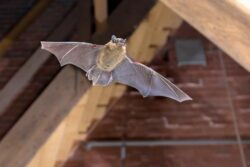Whether you’ve had to get rid of bats in the past or you’re concerned about a potential infestation, there’s good news: you can take several steps to avoid having bats in your attic. Knowing what draws bats into your home, and understanding their behavior in general, can help prevent these flying mammals from taking over your space.
Is it dangerous to have bats in the attic?
Cases of bat-to-human rabies transmissions are rare. According to the Centers for Disease Control (CDC), an average of only 6% of captured bats test positive for rabies. Additionally, vaccinations offer protection from rabies, even when administered after a patient has been bitten.
When untreated, though, being bitten by a bat with rabies can cause serious illness or even death. Many of these cases occur when children fail to tell their parents about encounters with bats. Others happen because adults aren’t aware of rabies dangers and don’t seek medical treatment. Having bats in your attic, garage, or elsewhere around your home can also put pets at risk.
How do bats get in your house?
Like many types of wildlife and other uninvited guests, bats are resourceful when it comes to finding ways to get into your home. The following areas, especially when not properly sealed, can be used as entryways inside:
- Vents
- Chimneys
- Window or framing gaps
- Holes or cracks in walls, fascia board, and roofs
Placing mesh over vents and chimneys goes a long way towards preventing bats in the attic and other seldom-used parts of your home. Look to seal gaps generally found in the soffit and siding throughout the exterior of your home to keep bats and other critters from getting inside.
Contact a McCall pest control professional to come to inspect the outside of your house for gaps and other possible points of entry. After they’ve scoped your property, they can provide recommendations for bat prevention.
How to Tell if You Have Bats in Your Attic
Now that you know how bats get in your attic, it’s important to understand the signs of an infestation. While bats leave some telltale clues of their existence behind (such as scratches on high areas of your walls), some clues are similar to those of a mouse infestation. Like mice, bats tip-off their presence to homeowners with the following signs:
- Ammonia-scented urine
- Small, oval-shaped droppings
- Nighttime squeaks and scratching noises
Bat droppings (also called guano) are often concentrated in one area and located below yellow strips that look a bit like dried juice. Bats also frequently leave behind greasy stains along the holes through which they enter your house. Seeing these winged creatures flying outside your home may also signal that they’ve invaded your indoor living space as well.
How to Get Rid of Bats in Your Florida Home
Like most wildlife, bats should never be handled by homeowners. There’s no reason to put yourself in danger when professional bat removal services are available. You can even get into legal trouble if you handle, trap, injure or kill bats, as they are a protected species. Wildlife removal professionals have the training, experience, and equipment to safely eliminate an infestation in your home. Even better, they’ll clean up after finishing the job.
McCall Service provides homeowners and commercial customers in Florida with safe, effective bat removal and pest control services. Call us at the first sign of bats in your attic to request a free quote. We’ll restore safety and comfort after bats invade your family’s living space.



